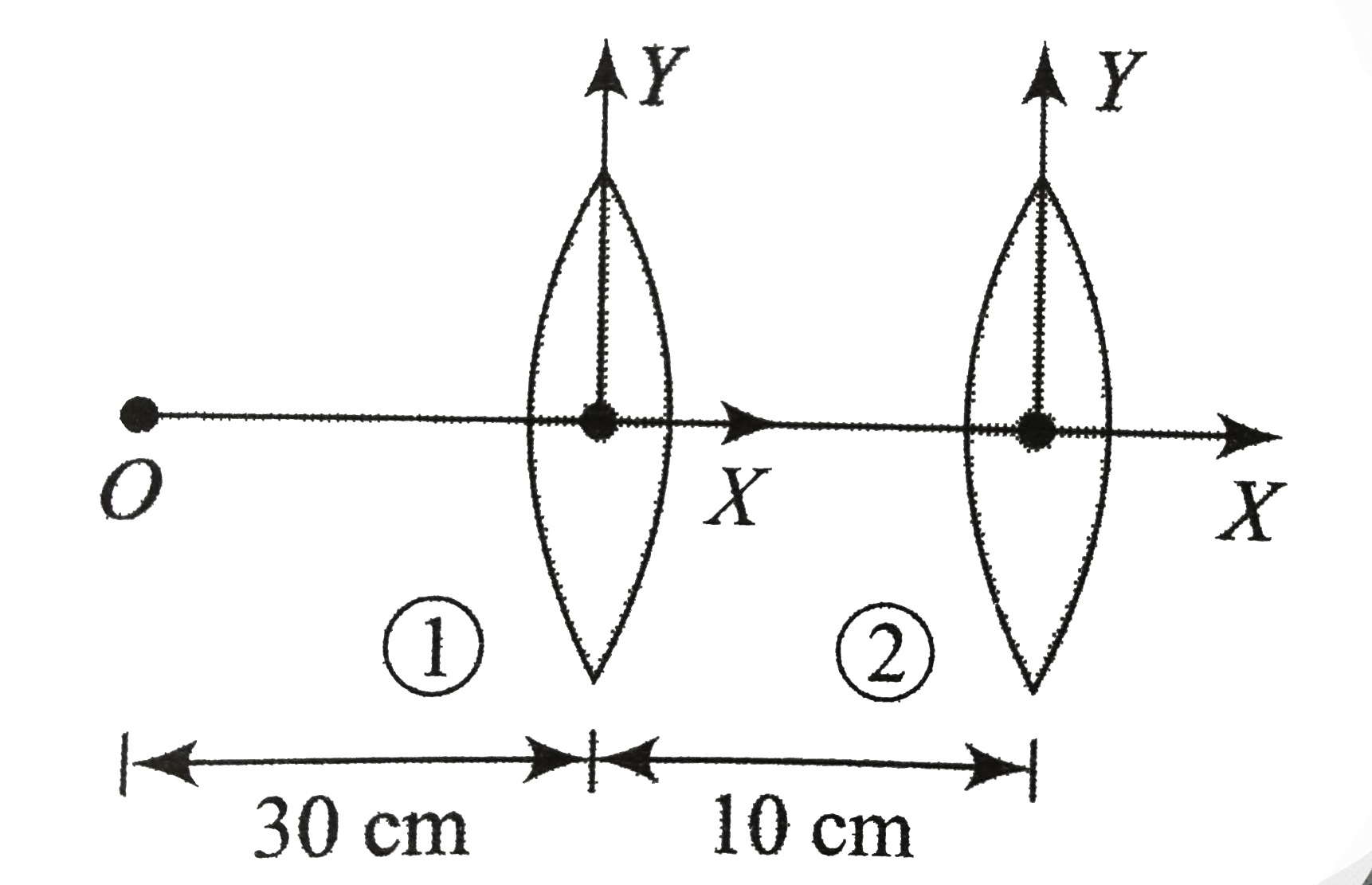Two lenses of focal lengths 20cmand−40cm are held in contact. The image of an object at infinity will be formed by the combination at
10cm
20cm
40 cm
infinity
The correct Answer is:C
To solve the problem of finding the image distance formed by a combination of two lenses with focal lengths of 20cm (convex lens) and −40cm (concave lens) when an object is placed at infinity, we can follow these steps:
Step 1: Identify the focal lengths
- The focal length of the first lens (convex) is f1=20cm.
- The focal length of the second lens (concave) is f2=−40cm.
Step 2: Calculate the equivalent focal length of the lens combination
The formula for the equivalent focal length f of two lenses in contact is given by:
1f=1f1+1f2
Substituting the values:
1f=120+1−40
Step 3: Simplify the equation
To simplify, we find a common denominator:
1f=240−140=140
Step 4: Calculate the equivalent focal length
Now, taking the reciprocal gives:
f=40cm
Step 5: Use the lens formula to find the image distance V
The lens formula is given by:
1V−1U=1f
Since the object is at infinity, U=−∞, thus:
1V−0=140
This simplifies to:
1V=140
Step 6: Calculate the image distance V
Taking the reciprocal gives:
V=40cm
Conclusion
The image of an object at infinity will be formed by the combination of the two lenses at a distance of 40cm from the lens combination.
---
- The focal length of the first lens (convex) is f1=20cm.
- The focal length of the second lens (concave) is f2=−40cm.
The formula for the equivalent focal length f of two lenses in contact is given by:
1f=1f1+1f2
Substituting the values:
1f=120+1−40
To simplify, we find a common denominator:
1f=240−140=140
Now, taking the reciprocal gives:
f=40cm
The lens formula is given by:
1V−1U=1f
Since the object is at infinity, U=−∞, thus:
1V−0=140
This simplifies to:
1V=140
Taking the reciprocal gives:
V=40cm
The image of an object at infinity will be formed by the combination of the two lenses at a distance of 40cm from the lens combination.
Topper's Solved these Questions
- RAY OPTICS AND OPTICAL INSTRUMENTSBOOK - NCERT FINGERTPS ENGLISHCHAPTER - RAY OPTICS AND OPTICAL INSTRUMENTSEXERCISE - Reflection Of Light By Spherical Mirrors
5 Videos
- RAY OPTICS AND OPTICAL INSTRUMENTSBOOK - NCERT FINGERTPS ENGLISHCHAPTER - RAY OPTICS AND OPTICAL INSTRUMENTSEXERCISE - Refraction
10 Videos
- RAY OPTICS AND OPTICAL INSTRUMENTSBOOK - NCERT FINGERTPS ENGLISHCHAPTER - RAY OPTICS AND OPTICAL INSTRUMENTSEXERCISE - ASSERTION AND REASON
15 Videos
- PRACTICE PAPPERBOOK - NCERT FINGERTPS ENGLISHCHAPTER - PRACTICE PAPPEREXERCISE - Practice Paper 3
50 Videos
- SEMICONDUCTOR ELECTRONICS : MATERIALS , DEVICES AND SIMPLE CIRCUITS BOOK - NCERT FINGERTPS ENGLISHCHAPTER - SEMICONDUCTOR ELECTRONICS : MATERIALS , DEVICES AND SIMPLE CIRCUITS EXERCISE - Assertion And Reason
15 Videos
Similar Questions
Two thin lenses of focal lengths 20 cm and 25 cm are placed in a contact. The effective power of the combination is
View SolutionTwo thin lenses of focal lengths 20 cm and 25 cm are placed in a contact. The effective power of the combination is
View SolutionTwo thin lenses of focal lengths 20 cm and -20 cm are placed in contact with other. The combination has a focal length equal to
View SolutionTwo thin lenses of focal lengths f1 and f2 are in contact. The focal length of this combination is
View SolutionIn a compound microscope consisting of two convex lenses of focal lengths 1.5 cm and 10 cm, the object is 2 cm from the objective and the final image is formed at the least distance of distinct vision (D=25cm). Find the distance of separation of the two lenses.
View SolutionA convex lens of focal length 20cm is placed 10cm away from a second convex lens of focal length 25 cm. What wil be the location of the image of an object at 30 cm in front of the first lens?

View SolutionTwo thin lenses, one of focal length + 60 cm and the other of focal length – 20 cm are put in contact. The combined focal length is
View SolutionA converging lens of focal length 40 cm is kept in contact with a diverging lens of focal length 30 cm. Find the focal length of the combination.
View SolutionA microscope consisting of two convex lenses of focal lengths 2 cm and 5 cm placed 20 cm apart. Where must the object be placed so that the final image (virtual) is at a distance of 25 cm from eye ?
View SolutionA convex lens of focal length 30 cm , a concave lens of focal length 120 cm , and a plane mirror are arranged as shown . For an object kept at a distance of 60 cm from the convex lens, the final image, formed by the combination , is a real image , at a distance of :
_E01_195_Q01.png)
|Focal length|=|Focal length|
= 30cm =120cm
_S01_267_Q02.png)
View Solution
